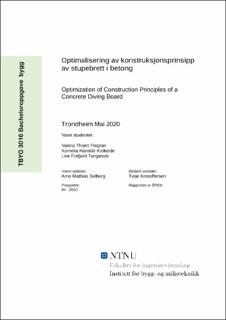| dc.contributor.advisor | Selberg, Arne Mathias | |
| dc.contributor.advisor | Kristoffersen, Terje | |
| dc.contributor.author | Frogner, Nanna Thoen | |
| dc.contributor.author | Krokeide, Kornelia Hareide | |
| dc.contributor.author | Tungesvik, Live Frafjord | |
| dc.date.accessioned | 2020-07-10T16:00:53Z | |
| dc.date.available | 2020-07-10T16:00:53Z | |
| dc.date.issued | 2020 | |
| dc.identifier.uri | https://hdl.handle.net/11250/2663738 | |
| dc.description.abstract | Bedrifter har ofte ikke tid til å vurdere konstruktive løsninger på grunn av stramme tidsfrister. Det anvendes stadig modelleringsprogrammer istedenfor håndberegninger. Ved prosjektering av Tromsøbadet oppsto det en problemstilling angående utforming av stupetårnet. Oppgaven tar dermed for seg optimalisering av konstruksjonsprinsipp for stupebrett i betong. Her stilles det olympiske krav i tillegg til krav for styrke og brukbarhet etter Norsk Standard.
Betong er et unikt materiale som har tilnærmet uerstattelig egenskaper og er anvendbart for de fleste bruksområder. Til tross for egenskapene bidrar produksjon av betong med et stort klimagassutslipp. Ved å optimalisere ulike konstruksjonsprinsipp kan mengden materiale begrenses.
Det er blitt sett på tre ulike utforminger for å besvare oppgaven; monolittisk-, T- og kassetverrsnitt. En god optimalisering vil i oppgaven ta for seg begrenset materialbruk, godt utnyttet tverrsnitt, praktiske løsninger og miljøbetraktede beslutninger. Samtidig skal stupebrettet tilfredsstille strenge krav mot svingninger, nedbøyning og styrke. På grunnlag av dette er det gjort beregninger, og videre diskutert hvilke løsninger som fungerer godt og hvorfor.
Monolittisk tverrsnitt ble det dårligste alternativet. På grunn av små påkjenninger resulterte det i mye ubrukt kapasitet i tillegg til unødvendig materialbruk. Den tunge konstruksjonen ga og en lav egenfrekvens som gjorde at den ikke tilfredsstilte olympiske krav til svingninger.
T-tverrsnittet hadde derimot en lav egenvekt og en større utnyttelsesgrad med tanke på kapasitet. Det tilfredsstilte krav til bæreevne best og nedbøyning godt. Likevel hadde profilet for lav egenfrekvens til å tilfredsstille kravet til svingning. Viktigst er at profilet oppfyller alle krav.
Den beste løsningen viste seg å være et kassetverrsnitt. Dette profilet tilfredsstilte best kravene fra Eurokode 2, samt de olympiske kravene. Det er også et tverrsnitt med redusert materialforbruk, på grunn av dens hule rom, som resulterer i det gunstigste alternativet også med tanke på økonomi og miljø. | |
| dc.description.abstract | Companies do not always have time to consider alternative constructive solutions due to tight schedules and deadlines. The use of modeling programs is often preferred over hand calculations. During the design of Tromsøbadet, issues considering the design of the diving platform arose. In this thesis we will therefore explore how to optimize the construction principle of a concrete diving board. The construction principle must fulfill the strength and usability requirements from the Norwegian Standards and Olympic standards.
Concrete is a unique material with nearly irreplaceable qualities. It is applicable for different purposes, but despite its qualities, concrete is bad for the environment. By optimizing different construction principles, the amount of the material might be limited which helps the environment.
For this thesis three different designs were considered: monolithic-, T- and box cross section. A proper optimizing in this thesis considers a limited use of materials, a high utilizations degree, practical solutions and sustainable decisions. In addition, the diving board will have to satisfy standards against fluctuations, deflection and strength. Built on this consideration there will be done calculations and discussions regarding which solution works the best and why.
The monolithic cross section ended up as the least attractive alternative. When faced with small forces it resulted in unused capacity which also led to unnecessary material use. The heavy construction had a low natural frequency which did not satisfy the Olympic criteria for fluctuation.
The T cross section on the other hand had a lower weight and therefore a greater capacity degree. The criterions for deflections and strength were also satisfied. However, the design did not satisfy the oscillation criteria as it had too low self-frequency. Most importantly for the design is to fulfill all requirements.
The best solution ended up being the box cross section. The design satisfied all requirements from Eurocode 2 and the Olympic. Due to its hollow room there where less materials used which results in a better economically and environmentally alternative. | |
| dc.publisher | NTNU | |
| dc.title | Optimalisering av konstruksjonsprinsipp av stupebrett i betong | |
| dc.type | Bachelor thesis | |
